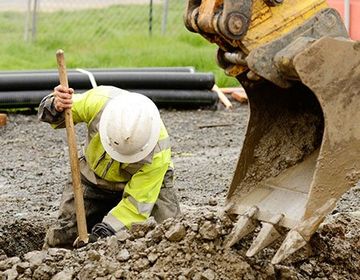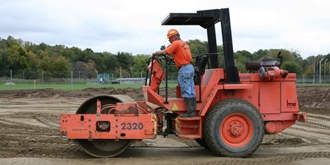Unveiling the Art of Excavation: Pro Tips for Safe and Efficient Digging
As soil is turned and earth is relocated, the complexities of excavation reveal themselves, requiring a keen understanding of equipment, soil make-up, security procedures, and environmental factors to consider. The proficiency needed to navigate these components properly can indicate the difference in between an effective excavation project and a prospective catastrophe.
Significance of Correct Tools
To make sure the safety and security and effectiveness of any kind of excavation task, using the suitable equipment is critical. The right devices not only boost efficiency yet likewise alleviate risks linked with digging. Excavation tasks vary in scope and complexity, varying from tiny domestic landscaping tasks to large building undertakings. No matter of the project size, having the correct devices can make a considerable difference in the outcome.
Excavators are fundamental pieces of equipment in any kind of digging procedure. These versatile machines can be found in different dimensions to suit different task needs. Mini excavators are optimal for smaller sized tasks, while larger excavators deal with extra comprehensive jobs efficiently. Backhoes are one more vital equipment kind, incorporating the functions of a loader and an excavator in one maker. They are beneficial for tasks calling for convenience and ability to move.
Bulldozers excel in tasks that require pushing large amounts of soil or particles. By investing in the ideal devices, excavation projects can be completed securely, on time, and with accuracy.
Comprehending Dirt Make-up
A detailed understanding of dirt structure is basic for implementing excavation jobs with accuracy and security. Recognizing the various sorts of soil is vital as it directly impacts excavation approaches, tools selection, and overall project efficiency. Soil composition typically includes four primary components: sand, silt, clay, and raw material. Each part has one-of-a-kind properties that affect exactly how soil responds to excavation procedures.
Silt fragments are smaller than sand however larger than clay, offering moderate drainage and communication. Organic matter, such as rotting plant material, affects dirt fertility and security.
Before beginning excavation, conducting dirt examinations to identify its make-up and attributes is vital. This information assists in choosing the suitable devices, implementing precaution, and establishing excavation approaches tailored to the particular dirt problems - dump truck companies in ohio. By comprehending dirt composition, excavation experts can boost project end results while making sure security and adherence to ideal methods
Precaution and Protocols
Recognizing dirt structure is the cornerstone upon which precaution and procedures for excavation projects are developed, making certain the well-being of workers and the success of the venture. When it comes to safety and security throughout excavation, there are several crucial procedures that have to be implemented to mitigate risks and avoid accidents.
Most importantly, prior to any excavating begins, a thorough evaluation of the site ought to be performed to identify any type of possible dangers such as below ground energies, unstable soil conditions, or neighboring structures that could Homepage pose a danger. It is important to have a proficient person oversee the excavation process to guarantee that all safety methods are adhered to strictly.
In addition, all employees involved in the excavation has to be correctly educated in safe digging practices and the proper operation of devices. By sticking to these safety procedures and procedures, excavation projects can be finished effectively and without occurrence.
Effective Excavation Preparation
When getting started on an excavation job, thorough planning is vital to guarantee effectiveness, security, and successful results. Efficient excavation preparation includes a number of key actions that are critical for the smooth implementation of the job. The primary step is to carry out a detailed site evaluation to recognize any type of prospective dangers, such as underground energies or unstable dirt problems. This information is important for developing a comprehensive excavation strategy that includes precaution and take the chance of mitigation techniques.
When the site analysis is total, the next step is to create a clear timeline and schedule for the excavation activities. This consists of figuring out the sequence of jobs, equipment demands, and workforce allotment. Proper organizing helps avoid delays and guarantees that the job remains on track.

Moreover, interaction among all team participants is vital during the preparation phase. Clear instructions, regular updates, and reliable sychronisation are essential for a successful excavation project. By investing time and effort in meticulous preparation, excavation groups can significantly enhance efficiency, minimize risks, and achieve successful outcomes.

Handling Environmental Considerations
With enhancing emphasis on ecological sustainability in construction practices, managing environmental factors to consider has actually ended up being an important element of excavation tasks. Excavation activities have the possible to affect the surrounding setting via soil disintegration, debris drainage, habitat disruption, and contamination of water resources. To alleviate these threats, it is vital to implement best methods that prioritize environmental security.

Moreover, correct waste management is essential to stop dirt and water contamination. Carrying out treatments for the disposal of hazardous materials, recycling of Get More Information waste products, and lessening the usage of damaging chemicals can substantially lower the ecological influence of excavation jobs. By incorporating these practices right into excavation preparation and execution, building firms can guarantee that their projects are not just risk-free and effective yet also environmentally accountable.
Verdict
In conclusion, mastering the art of excavation requires a detailed understanding of proper equipment, soil composition, precaution, and efficient preparation. By following these standards and considering ecological variables, excavations can be conducted safely and effectively. It is essential to prioritize safety and security and efficiency in every digging task to ensure successful results.
As dirt is turned and earth is relocated, the details of excavation disclose themselves, requiring an eager understanding of tools, dirt composition, security protocols, and environmental factors to consider.To ensure the safety and effectiveness of any excavation project, using the appropriate equipment is critical.A comprehensive understanding of dirt make-up is essential for performing excavation tasks with accuracy and security. Recognizing the various kinds of soil is crucial as it directly affects excavation approaches, equipment selection, and general project performance. By recognizing dirt composition, excavation professionals can enhance project outcomes while guaranteeing security and adherence to finest techniques.